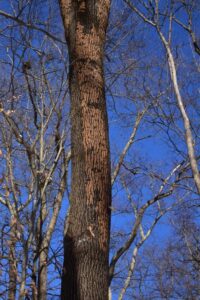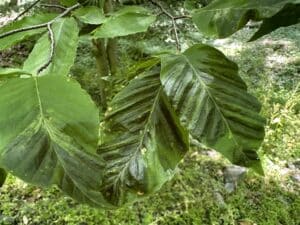Hello, fellow lovers of all things green,
The influx of insects and other diseases killing stands of trees is heartbreaking. We feel helpless as remedies are experimental or beyond our means to implement. Then comes acceptance—the awareness that the gift of life is making the most of everything while it is here and while we are here. Nothing lasts forever other than our souls. Losing our much-loved trees is an opportunity to plant beautiful native replacements and, perhaps more importantly, to allow Mother Nature to do the same. There is hope beyond our declining native trees.
Causes of Our Declining Native Trees

Ash Trees (Fraxinus) are being devastated by the Emerald Ash Borer
The Emerald Ash Borer (EAB) devastated our native ash trees that comprise roughly ten percent of the forests in our area (NJ/PA) —a woeful fate caused by an alien wood-boring insect that made its way here, likely from overseas cargo. Discovered first in Michigan in 2002, the Emerald Ash Borer is now in 37 states. Some specimen trees remain standing thanks to trunk injections of Emamectin benzoate, also known as Tree-age, which a professional injects into a tree’s vascular system. But it’s expensive and not practical for stands of trees.

Wolf Tree, a grand White Ash tree in Mount Olive, NJ, is lovingly being treated for EAB.
Then there are the Spongy Moths (formerly called Gypsy Moths) destroying trees. Thankfully, a healthy tree can survive two or three consecutive defoliation attacks, but they weaken the tree, making it susceptible to other diseases and drought.
More recently, Beach Leaf Disease (BLD) caused by a non-native foliar nematode has arrived on the scene, which darkens and distorts leaves, reducing photosynthesis by sixty percent. Nematodes are microscopic worms, not visible to the naked eye. We don’t know where they came from or how they spread so quickly, but they think birds are likely involved in transporting the nematodes. American beech (Fagus grandifolia) is a dominant tree in forests throughout the northeastern U.S. and Canada.
The Progression of Beach Leaf Disease is Alarming
It’s alarming how many trees are already infected, including my beloved Mr. Beach, who stands majestically on the front lawn, shading our home. Found first in Ohio in 2012, Beach Leaf Disease is now in fifteen states. Researchers observe trees dying six to ten years after infection. Younger trees, with fewer leaves, are impacted more quickly.

Early Symptoms of Beech Leaf Disease
American Beech trees host 100 species of butterflies and moths. Their high-protein seeds are essential food for black bears, turkeys, rodents, raccoons, and deer, though the trees are deer-resistant. They are one of the few trees that can thrive in the deep shade of the forest, so the thought of losing them is devastating, as the vacant forest floors will be vulnerable to more invasive plants.
There is no cure, though promising trials show that Thiabendazole, a fungicide injected into the vascular system of trees requiring an expert, prevents leaf symptoms and dieback and significantly reduces the number of nematodes in dormant buds. But what can we do now?
Planting New Native Trees Brings Hope
A paper published by Rutgers New Jersey Agricultural Experiment Station recommends underplanting stands of beech trees with native trees such as white oak, chestnut oak, swamp white oak, and shagbark hickory—my favorite. Then there’s pignut hickory, mockernut hickory, bitternut hickory, American holly, white pine, and black gum. Choose species suitable for your site conditions.

Standing below the Momma Tuliptree feels sacred.
They suggest planting dense stands of 10-30 small trees 4-8 feet apart to replace one mature beech tree, protecting them from deer damage with 6-foot-high wire mesh circles. Adding tree tubes to protect them from moles and voles is also wise.
It occurred to me: Why not plant a few trees around the at-risk trees in our yards? While walking around the property, I noticed many volunteer Tulip trees (Liriodendron tulipifera) sprouting. I like to think Mother Nature is stepping in. Also known as Tulip Poplar, Yellow Poplar, or Tulip Magnolia, they grow about fifteen to twenty feet in six to eight years. But despite being fast growers, they are hardwood trees.
So, I’ll transplant one of the volunteers next to my beloved Mr. Beech, without losing hope that he could survive.
Garden Dilemmas? AskMaryStone@gmail.com and your favorite Podcast App.
There’s more to the story in the Garden Dilemmas Podcast, including the history of the Wolf Tree, a 400-year-old White Ash tree you’ll adore.
Related Posts, Podcasts, and Helpful Links:
Ep 45. Beloved Mr. Beech / Beloved Beech Trees – Blog Post
Ep 61. A Story of Treasured Tuliptrees / Treasured Tuliptrees – Blog Post
Ep 101. Woodcock Dance- Making a Meadow
Woodcock Dance – Making a Meadow – Blog Post
Rutgers New Jersey Agricultural Experiment Station paper- Beech Leaf Disease & Management Options



Thank you for shedding light on such an important issue. It’s heartbreaking to see native trees in decline, but also heartening to learn about the efforts being made to preserve and reintroduce them. Your message reinforces the power of hope, stewardship, and collective action. I’ll definitely be more mindful of how I can support native species in my own area.
That’s wonderful. The more of us that support native species, the more our wildlife will thrive. Thank you for reading my post, Mary Stone